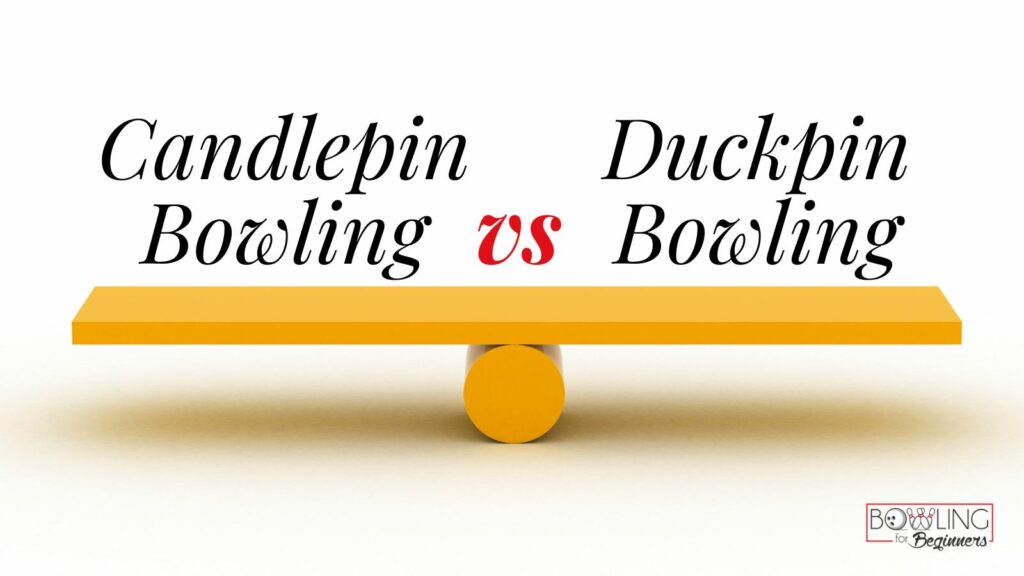
Candlepin and Duckpin bowling are two variations of tenpin bowling. Both offer unique experiences and challenges. If you're unsure how to tell them apart, this guide will help you understand the differences and similarities between these two bowling games.
Let's get into our candlepin bowling vs duckpin bowling comparative guide.
Contents
Candlepin Bowling vs Duckpin Bowling
Candlepin bowling vs duckpin bowling are similar but are very different.
Each game has its unique:
- history
- equipment
- rules
- gameplay
- popularity
The uniqueness of the rules and equipment creates a distinct playing experience.
Key Takeaways
- Origins and Popularity: Candlepin bowling started in Worcester, Massachusetts in 1880. Duckpin bowling began in Lynn, Massachusetts in the early 1890s. Candlepin is popular in New England and Canada; duckpin is more Northeastern U.S. focused.
- Equipment Differences: In Candlepin bowling, the pins are 15 inches tall and light, and the balls are small without finger holes. Duckpin's pins are shorter and squatter, measuring 9 inches and weighing 1.5 lbs. The balls used are slightly larger, with a diameter of 4.75 inches and weighing 3-4 lbs.
- Gameplay and Scoring: Both games allow three rolls per frame, with downed pins (deadwood) not cleared between rolls. Strikes and spares are scored similarly in both, with additional points for subsequent balls.
- Technique and Challenge: To play each game, you must aim well and throw differently because of the small balls and pins. Candlepin is noted for its higher difficulty due to the slender shape of the pins.
- Family Friendly and Strategic: Both games are family-friendly and strategic. People of all ages can play them. The strategic element involves using downed pins during play. Downpins make the games more dynamic and unpredictable.
Historic View
Candlepin bowling history:
- originated in Worcester, Massachusetts, in 1880
- invented by Justin White when he added candle-shaped pins to the popular tenpin bowling game
- The sport quickly gained popularity and spread throughout New England and Eastern Canada.
Duckpin Bowling differs:
- has been around since the early 1890s,
- its origin is documented in the Boston Globe as Lynn, Mass.
- word of mouth origin is believed to be from Baltimore, Maryland, and created by two men named John McGraw and Wilbert Robinson at a bowling alley they owned.
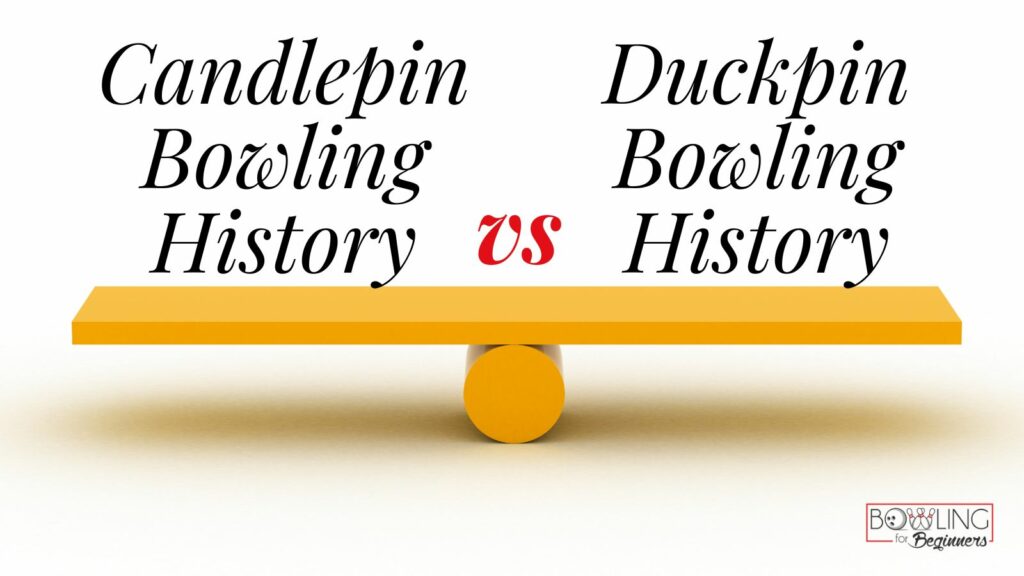
Equipment
Pins
Candlepins have:
- are tall (15 ¾ inches) and cylindrical
- lightweight (3lbs is max)
- candlepin bowling pins have a beveled top and bottom
Duckpins differ:
- are short (9 inches) and squat (4.75 inches tall and with 4-5 inch diameter at the widest part)
- lightweight (1.5lbs)
- chucky (hefty) middle section
Ten pins are used in both Candlepin and Duckpin bowling.
Balls
Candlepin Balls are:
- max diameter is 4.5 inches
- weight range is 2.5 to 2.7lbs
Duckpin Balls differ:
- measure only 4.75 inches in diameter
- duckpin bowling balls weigh between 3-4 pounds
They both share not having finger holes. The balls must be palmed by holding it in the center of your hand.
Candlepin Lane Dimension are:
- width is 41 inches wide
- approach area measures 14-16 ft
- candlepin lane dimensions are 60ft long from the foul line to the headpin
- lob line (where the ball must hit the lane) starts at the foul line is goes 10ft down the lane
- deadwood line is the boundary line candlepins can't cross to remain live or playable
Duckpin Lane Dimensions differ:
- width is 42 inches wide
- approach area is optional
- approach area dimensions can vary from 0ft to 16ft
- lane length can vary from 24ft to 63ft
Candlepin and Duckpin bowling share small ball returns and gutters (troughs).
*note: all variations of bowling can have lane dimensions of traditional ten pin bowling
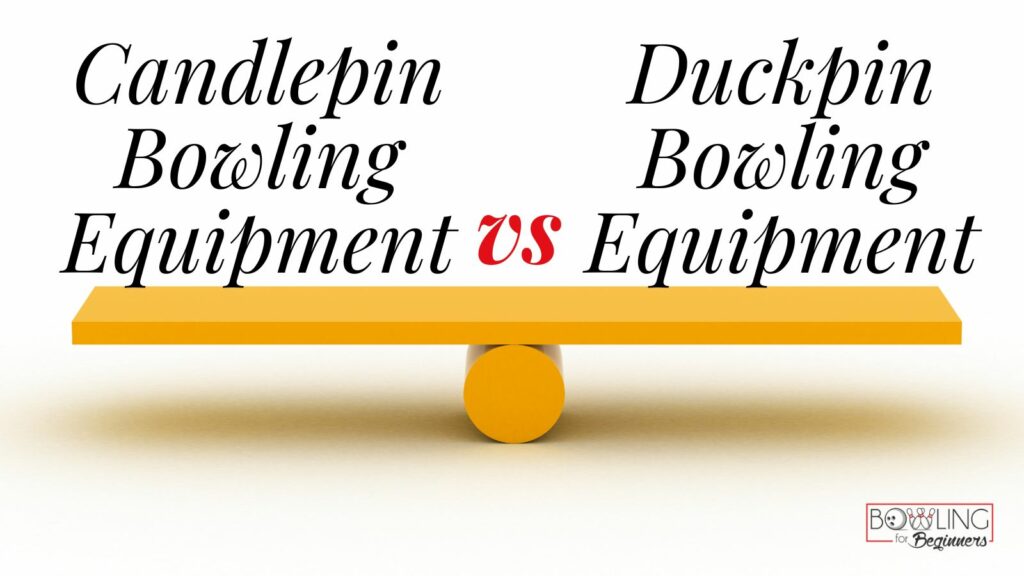
Candlepin and Duckpin Bowling Rules
- each player gets three rolls per frame
- fallen pins, known as "wood," aren't cleared away between rolls. *This creates opportunities for some interesting shots where you can use the downed pins to knock over standing ones*
- You've got to consider the wood or the lane as an extension of your playing field, which can make the game more dynamic and unpredictable.
- Read about duckpin scoring in this article.
Basic Gameplay For Candlepin and Duckpin Bowling
Wondering how a game of candlepin bowling actually plays out? Here's a list of the basic steps:
- Start the Game: Determine the playing order. The first player gets ready to bowl, standing behind the foul line at the start of the lane.
- Grip and Roll: Grip the ball in your palm, aim, and roll it toward the pins. The rolling technique can be similar to that in ten-pin, but the lighter weight of the ball may require some adjustments.
- Leave the Deadwood: Unlike ten-pin bowling, knocked-down pins (referred to as "deadwood") aren't cleared away between rolls in a single frame.
- Complete the Frame: Each player gets up to three rolls per frame to knock down as many pins as possible.
- Keep Score: Track points based on how many pins you knock down. Strike: Knocking down all pins in one roll (10 points plus the points from the next two balls). Spare: Knocking down all pins within a frame on the second or third roll (10 points plus the points from the next ball). When there are standing pins at the end of the frame, you score the number of pins knocked down.
- Determine the Winner: After completing 10 frames, tally up the scores. The player or team with the highest score wins.
To learn more about duckpin bowling rules, check out this article.

Popularity Locales
Candlepin bowling is popular in Canada and parts of New England. Some alleys are also found in the Mid-Atlantic region.
Duckpin bowling is primarily played in the Northeastern United States and has a smaller following than traditional or Candlepin bowling.
Candlepin Bowling and Duckpin Bowling Similarities
Scoring
Both Candlepin and duckpin use a similar scoring system. In both games, players aim to knock down all the pins on each frame, with bonuses for strikes and spares.
Technique
Technique similarities are also shared between candlepin and duckpin bowling. In both games, players must have a precise aim and use a similar throwing motion to knock down the smaller pins. Additionally, both games require players to use finesse and strategy to score well.
Family-Friendly Activity
People of all ages can enjoy Duckpin and candlepin bowling. Children may find playing these games easier with smaller balls and pins easier than traditional bowling.
Deadwood
In both games, knocked down pins ("deadwood") are not cleared away between rolls within a frame. Players can use these downed pins strategically to knock over more pins.
Rolls Per Frame
Both Candlepin and Duckpin bowling give players three rolls per frame to knock down all the pins.
Difficulty Compared to 10-Pin Bowling
The smaller ball sizes and unique pin shapes become a barrier to scoring, compared to 10 pin bowling. For these differences, scores are lower in candlepin and duckpin bowling. Strikes and spares are harder to achieve, making the games more challenging.
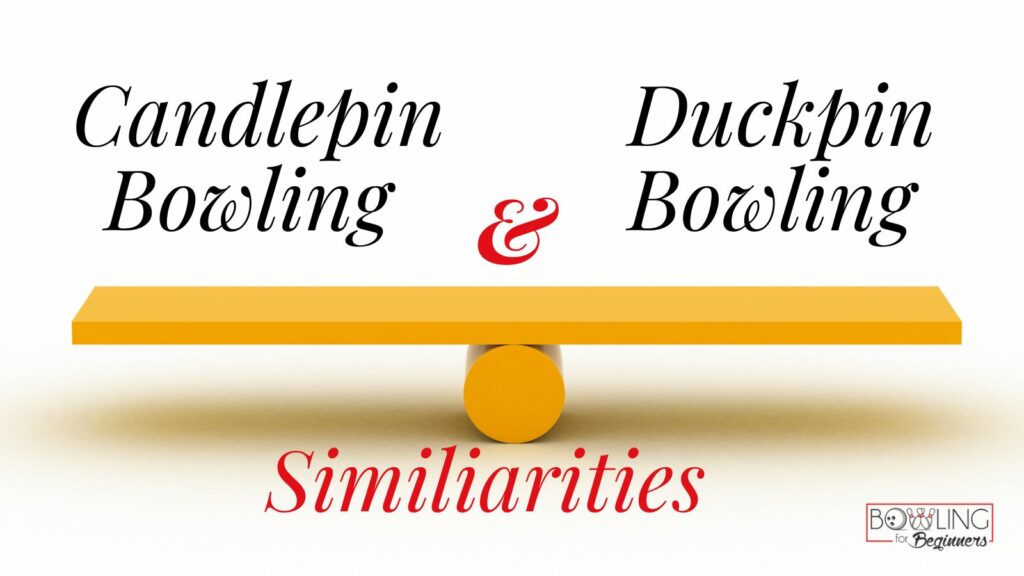
Frequently Asked Questions
Do candlepin bowling balls not have finger holes?

No. Candlepin bowling balls do not have finger holes.
Typically, candlepin bowling balls do not have finger holes. This is due to the smaller size of the ball and the fact that players use a different grip technique compared to traditional bowling.
Why is Candlepin bowling harder?
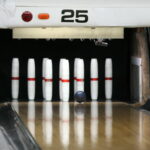
Pin shape, ball size, ball weight, deadwood, and accuracy are a few reasons Candlepin bowler is hard to play.
Here are the details:
Pin Shape: Candlepin pins are tall and slender, making them less likely to fall over or to avoid contact with a smaller ball.
Ball Size and Weight: Candlepin balls are smaller. The smaller size makes it harder to achieve a strike because the ball has less surface area to come in contact with the slender pins.
Deadwood: In Candlepin bowling, the deadwood (or downed pins) can be a barrier, blocking your ball from hitting the standing pins.
Precision Requirement: The slender shape of candlepins demands higher accuracy for successful strikes and spares.
Which bowling variation should you play?

The different types of bowling are five pin, nine pin, ten pin, duckpin, mini-bowling, candlepin, lawn, petanque, and bocce ball.
Here's a brief summary to help you decide:
For Beginners: If you're new to bowling, ten pin and duckpin might be suitable options. The pins' shape is more similar to traditional bowling than candlepins'. What's more, the ten pin bowling ball is larger, which can help knock down the pins. Just know that you will still be up against a formidable challenge whether you go with duckpin or candlepin.
For Challenge Seekers: Candlepin and five pin bowling are your go-to if you're looking for a game that demands precision and strategy. With its slender pins and smaller balls, candlepin bowling requires higher accuracy, making it the perfect choice for those seeking a challenge.
For Strategy Lovers: If the strategic element of bowling excites you, both duckpin, candlepin, lawn bowling, and nine pins can offer varying levels of strategy.
Consider the Fun Factor: Both games are fun but offer different fun. Duckpins might be seen as slightly more relaxing and less challenging (when compared to candlepins), while candlepin can be seen as more intense and competitive. Choose the one that aligns with your idea of fun!
Availability: Depending on where you live, one game may be more easily accessible than the other. While duckpin bowling is popular in the Northeastern United States, candlepin is primarily found in New England and parts of Canada.
If you're feeling adventurous and can find alleys where five pin bowling, nine pin bowling, ten pin bowling, duckpin bowling, mini bowling, candlepin bowling, lawn bowling, petanque or bocce ball are available, why not try both games? You might find that you enjoy one over the other, or perhaps even enjoy both equally!
Related Articles
So, there you have it - candlepin vs. duckpin bowling and everything you need to know about them. We hope you found all the information you were looking for, and we wish you the best as you explore regular bowling variations.
Kira Byrd, a Certified Fraud Examiner, holds a B.S. in Accounting from the University of Alabama at Birmingham. With a passion for bowling from her childhood, Kira has poured her expertise and personal experiences into creating and nurturing Bowling For Beginners. Kira's mission is to meet new bowlers where they are and guide them toward consistently achieving higher scores. With a focus on skill development and strategic techniques, she empowers readers to take control of their game and unlock their true potential.
Bowling For Beginners embodies strict editorial integrity, ensuring reliable and unbiased information. Kira's commitment to delivering valuable insights and practical strategies is reflected in every article. Here's an explanation of our editorial policy and how we get money.


